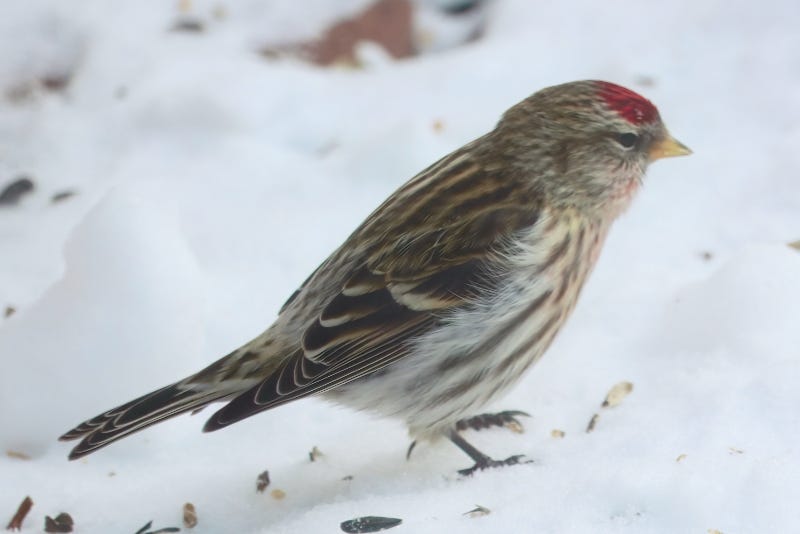12 Years of winter birds
40 species, one small location–Dec to March - 2013 to 2025
Since I retired, J and I have spent four months each winter (December to March) regularly visiting a nearby bird banding station where we replenish an extensive series of bird feeders and then walk/snowshoe the trails, taking a census of the birds that are around. Much as we like the warmer months and the bright birds they bring, deep winter birding is a special treat for us that we look forward to every year. A bonus is that because this is a research area owned by a university public access is not granted … consequently we have the whole place to ourselves for as long as we spend there. Just fields, woodland, a cat-tail marsh, deer, foxes, coyotes, deep crisp snow, plenty of birds and NO PEOPLE. What’s not to like? It can be a bit chilly when the windchill is below -20C but we are tough people with stout boots. Getting into the site can be a bit of a slog along an adjacent field, usually on snow shoes, to find a gap in the fence. There is a gated road but once the snow builds up that’s pretty well unusable … best to leave the car outside and get some exercise.
After doing this for some years I thought to make a list of how many, and which, species of birds we had enjoyed there on our visits. Rather astonishingly, I found that our MBO-List comes to a remarkable 40 different species of birds, I had thought it would be fewer. Some, of course, we see every time we visit while a few have been only once or twice visitors … but there is always something to enjoy. More to the point, it is good to know that even in the harshest conditions there are creatures out there, this close to a major North American city, that manage to make a decent living. The species are these …
Big Birds and Raptors
Canada Goose, Wild Turkey, Ruffed Grouse, Rock Pigeon, Mourning Dove, Sharp-shinned Hawk, Northern Harrier, Red-tailed Hawk, Great Horned Owl
Corvids, Woodpeckers etc
Red-bellied Woodpecker, Downy Woodpecker, Hairy Woodpecker, Pileated Woodpecker, Merlin, Northern Shrike, Blue Jay, American Crow, Common Raven
Winter regulars
Black-capped Chickadee, Tufted Titmouse, White-breasted Nuthatch, European Starling, American Robin, Bohemian Waxwing, Cedar Waxwing, House Sparrow, House Finch, Purple Finch
Winter Finches, Sparrows etc
Evening Grosbeak, Redpoll, White-winged Crossbill, Pine Siskin, American Goldfinch, Snow Bunting, American Tree Sparrow, Fox Sparrow, Dark-eyed Junco, White-throated Sparrow, Red-winged Blackbird, Northern Cardinal
Species in italics above have been seen only a couple of times, certainly not every season though the Red-bellied Woodpecker in the past couple of years has suddenly become a regular. He really likes suet at the feeders.
Any downside? Not really, though the seed feeders are secured to their supports against wind and squirrels with chains and metal dog clips that cannot be unfastened with gloves on … cold metal at -20C is no fun. Looking forward to still be doing this when I am 100, though I might need someone to fasten the snowshoes on my feet. by then as I won’t be bending so easily.
Sometimes, we meet deer … life isn’t all about birds 😉
How to spend a snow day
Just some illustrated suggestions. All tried and tested for efficacy.
The light is returning
This would be a great book for any enquiring child
… wish I had had it when that was me. So important to spread the knowledge.
In the comments to the post linked below, someone offered this. I was the sort of kid who would have done this sort of thing if permitted … but then I was also the sort of kid that grew up to make a living doing pathology 😉
I particularly like some children's natural history books of yesteryear because they often contain advice that would make today's parents' hair stand on end e.g. I used to have a book from the 1950s (which I now regret having lent to someone) that advises young naturalists to visit their local game dealer and ask for deer heads, then tells them to allow one to rot in a bucket of water, then hang in the back yard in a muslin bag to allow maggots to clean the flesh. I knew someone who did similar with (he claimed) badger roadkill, turning the skulls into bedside lamps. Standard method amongst bona fide zoologists for skeleton preparation then but today it might sound a bit Satanic. Educational but not the kind of advice you see on SpringWatch...
Relocating Beavers
Despite the title of the Substack, this has nothing to do with gardening. It is, however, really interesting, quite fun in parts.
















Richard: As this Subscriber of yours sits here slowly regenerating from a bout of this severe flu that has floored many people throughout North America, it has been comforting to be able to take a daily "virtual" hike through the beautiful, snow-covered tundra that you depict with your words and photos. Your moniker of "Richard - Out Walking" makes me feel like I am tagging along with a more experienced, neighborly hiker while absorbing their wisdom about the birds I didn't know much about. Thanks for your posts as I really enjoy them!
Some great birds and I particularly like no people.